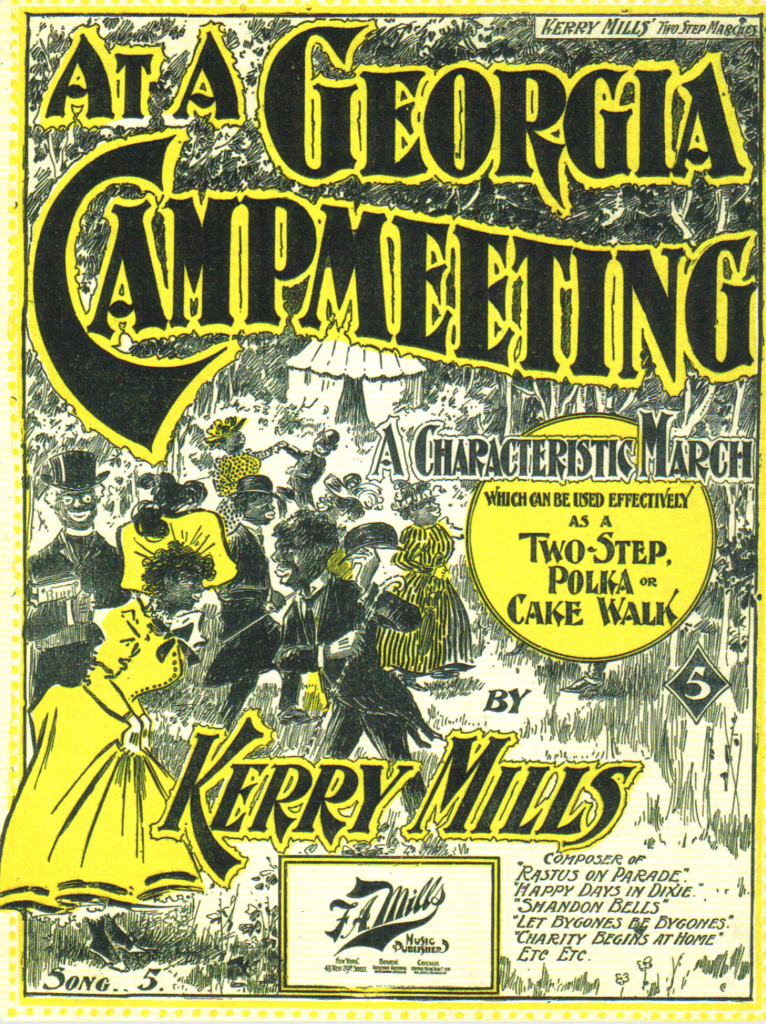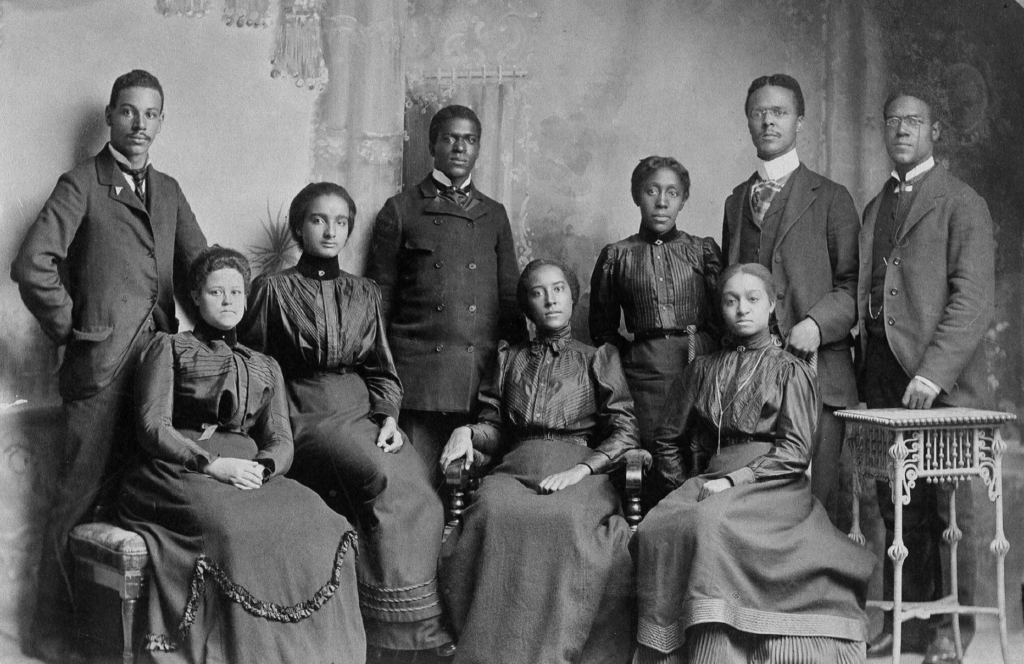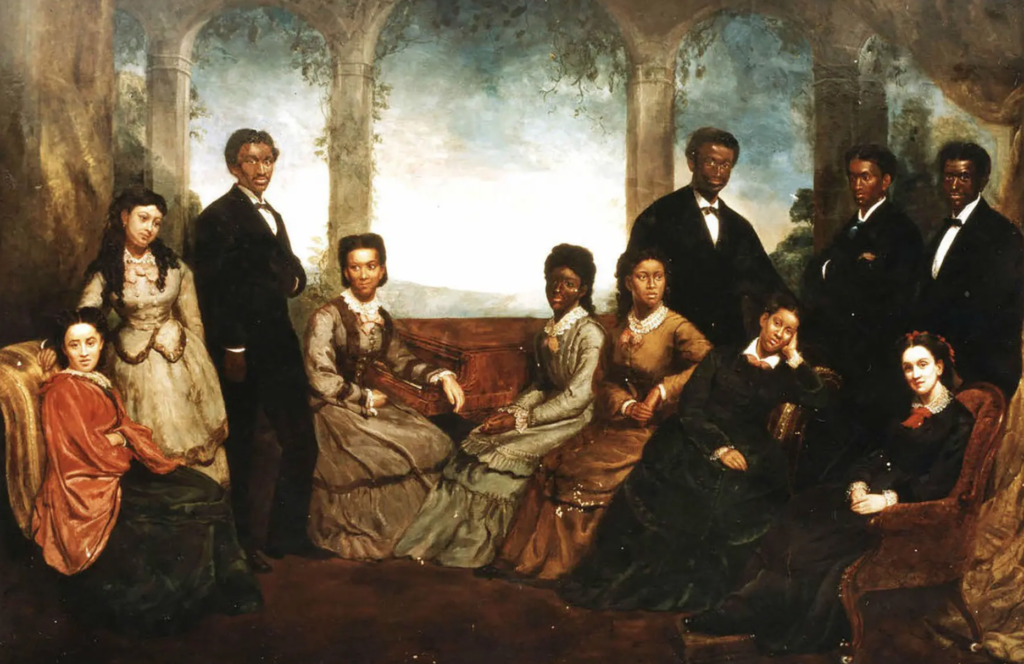The spiritual, the musical development credited with begetting so many American popular musical forms, was jump-started in the White communities of the South around 1800 when British evangelists brought their spirited, pull-out-the-stops style to America. Their revival meetings featured lively group singing, many melodies being imported from secular British traditions like folk tunes and tavern singing.
The high‑energy worship appealed to those unsatisfied with the sedate Puritan style; it certainly appealed to African Americans, whose own traditions had never divorced music from group participation or spirit from body. Unlikely as it may seem from our vantage point over the present Sunday morning racial chasm, from about the 1820s Blacks attended the same revivals.[1] Though the proceedings were not necessarily integrated, a key musical interchange took place here.
[1] The sentiment for racial separation and control in the
deep South was not entirely shared by poor Whites
in the hills further north, away from the plantations.
In much the same way that Blacks in South Africa adapted European hymns and sang them in their own style as freedom songs, Blacks in the US South infused the White spirituals with their own musical and social sensibilities. For example, the group repetition of an unchanging line as the song leader progresses through a text was a West African retention, first noted in the “ring shouts” from slavery times. As described by a visitor to the Sea Islands off South Carolina in 1864:
The children form a ring, and move around in a kind of shuffling dance, singing all the time. Four or five stand apart, and sing very energetically, clapping their hands, stamping their feet, and rocking their bodies to and fro. These are the musicians, to whose performance the shouters keep perfect time.[i]

They kept perfect time for a good reason: the lyrics being shouted were dance instructions, called by callers.[ii] Could this have been the birth of square dance callers? Some say so. We will hear these calls again from Black banjo artists who played for dancers just before the advent of string bands.
The debate over who influenced whom often focuses on these shared camp meetings. There’s no doubt of the European source of many of the songs. Many musical characteristics were shared between the White and Black, the Anglo-Celtic and African, notably pentatonic scales and a slight flatting of thirds and sevenths. But attention should also be paid to the differences in performance, which are accentuated once camp ends and Blacks and Whites decamp down their different roads through history.
Blacks borrowed selectively, taking songs that meshed well with their sense of musical style, and transformed them in order to make them their own. African American style featured syncopation, poly-rhythmic hand-clapping, and dancing. All these practices were and are rare in White congregations.[iii] The African American style, as Bruno Nettl summarized it, featured “hot rhythm, much variation, preference for part-singing, antiphony, and response.”[iv] The entire process was described by D.K. Wilgus as a sort of semi-hybridizing:
The Negro has preserved, borrowed, and re-created, as has the white. The two races share a tradition which they tend to treat distinctively.[v]
Soon Blacks had their own camp meetings. Here were born such tunes as “Nobody Knows,” “O Susanna,” “Go Down Moses,” “Joshua Fit the Battle of Jericho,” and “Swing Low, Sweet Chariot.”
Outside of camp meetings, how were spirituals written, or developed, or made up? One informant explained:
I’ll tell you, it’s dis way. My master call me up and order me a short peck of corn and a hundred lash. My friends see it, and is sorry for me. When dey come to de praise-meeting dat night dey sing about it. Some’s very good singers and know how; and dey work it in—work it in, you know, till they get it right; and dat’s de way.[vi]
Some of these “very good singers” could have been the Mahalia Jacksons, Aretha Franklins or Al Greens of their day.
And of course the songs served double duty, as did Christianity in general for African-Americans. Songs about heaven were also songs about escape from slavery. Dual meanings abounded, as they did in the blues, where sexual innuendo was more easily deciphered than some of the references to White and Black social interactions. Due to the dual life Blacks lead in White-dominated society, the practice of dual meaning in art and religion has come to pervade even the larger society, as we saw with minstrelsy. This veil over hidden meanings is occasionally lifted:
Got one mind for white folks to see,
‘Nother for what I know is me;
He don’t know, he don’t know my mind,
When he see me laughing
Just laughing to keep from crying. [vii]
And in fact, one could say the intertwined Black, White and other roots of modern American art forms reveal at least dual messages when they are unraveled for their hidden content.
The spirituals would in time be smoothed out and made more regular, as would the blues, but in their original state they were something quite apart both from the White version and from what was to come. Zora Neale Hurston, a leading Black writer on folklore who was active in the 1920s Harlem Renaissance, described the difference with a parable:
A white man built a house. So he got it built and he told the man: “Plaster it good so that nobody can see the beams and uprights.” So he did. Then he had it papered with beautiful paper, and painted the outside. And a Negro built him a house. So when he got the beams and all in, he carved beautiful grotesques over all the sills and stanchions, and beams and rafters. So both went to live in their houses and were happy.[viii]
The prevalence of pentatonic scales in both the Scottish and West African traditions helped facilitate interchange. Studies collected by George Pullen Jackson in the 1930s show numerous cases of the revivalists’ “shape note” songs”[2] moving from White tradition to Black, and Jackson notes that many of the tunes that did make this move shared scales with traditional West African music.
[2] So named for their depiction in sheet music employing
a distinctive shape for each note, to facilitate reading by unschooled singers.
In the interest of fundraising, Black college groups presented Jubilee singing, initiated by Nashville’s Fisk University in the 1870s. Spirituals from the slavery era were brought forth in a more polished form by troupes of formerly enslaved Black students who toured the country; for the first time, large numbers of Whites heard serious presentations of Black spiritual music.
This singing movement was furthered by the matriculation at Fisk of hundreds of schoolteachers, all rigorously trained in the singing and teaching of the Jubilee style—a style, once again, that incorporated Afro and Euro elements. This time, there was more of a European manner constructed on mixed Euro-African matter. It was a style of great dignity, criticized as lacking in passion by those who preferred more rustic, untutored styles. The choirs were, after all, trained by George White, a White man, to sing in a controlled, precise manner. But they were a big hit throughout the country and in Europe, and shaped Black religious singing for decades.[ix] Mark Twain, who relaxed at home by singing Negro spirituals, hosted the Fisk singers in 1897 and commented on their music:
It is utterly beautiful, to me…and I wish it were a foreign product so that [America] would worship it and lavish money on it and go properly crazy over it.[x]

Modern gospel music has its roots in White religious movements in the South around the 1870s. It would not really take hold in the Black community for a generation, and when it did, the character of performance was again altered, from restraint to passion. Words like hoarse, coarse, raspy, gravelly, and shrill give us a clue.[xi] Black gospel quartets in the 1920s placed more emphasis on lead voices instead of an exclusively ensemble presentation. This opened the way for nonsense syllables as background for the lead singer—a direct antecedent of doo-wop. The new arrangements also featured blue notes, syncopation, and faster versions—gospel has always absorbed new Black popular styles, and vice versa. In the forties, guitars were added, and the later addition of more instruments led to still further diversification of vocal arrangements. [xii]

Later, White gospel quartets would pick up pieces of the styles of their Black counterparts and of barbershop groups, adding syncopation and antiphony where before there had been only strictly in-time renditions. They would adapt Black gospel numbers like Thomas Dorsey’s “Precious Lord, Take My Hand” and Charles Tindley’s “We’ll Understand It Better By and By.” But they never picked up the growling, repeating, bending, and generally wringing the guts out of a word.
Indirectly, though, White artists and fans did pick up big doses of Black gospel’s feeling, as it coursed through secular music. Without gospel, there would be no rhythm and blues, nor its various children. Without the quartets, choirs, and continuing morphing of gospel styles back and forth with Black popular music, no Mick Jagger. Perhaps we can thank the Pentecostal church (along with various musicians around Memphis) for the music of one of its members, young Mr. Presley. We can thank Ray Charles for secularizing gospel, though not everyone was thankful at the time. Then again, Mahalia Jackson was a Bessie Smith fan. Thank the Lord for that, too.
[i] Forten, Charlotte, “Life on the Sea Islands,” 1864, in The Negro Caravan, 657.[ii] Abrahams, 105.
[iii] Oliver, 13.
[iv] Wilgus 1981, 80.
[v] loc. cit.
[vi] Brown, 413.
[vii] Lawrence Gellert, “Me and My Captain,” reprinted in The Negro Caravan, 471.
[viii] Zora Neale Hurston, “Spirituals and Neo-Spirituals,” in Cunard, 224.
[ix] Doug Seroff, “Nashville – Historic Capital of Spiritual Singing”, in Nashville Gospel Arts Day program, June 19, 1988; Lynn Abbott, personal communication, September 14, 1994.
[x] cited in Fishkin 1993, p. 5.
[xi] Stephens, Robert, 26-27.
[xii] Doug Seroff, Nashville Gospel Arts Day, program, June 18, 1989, 9.
